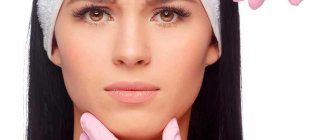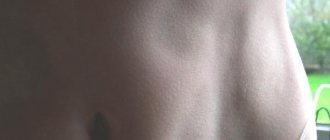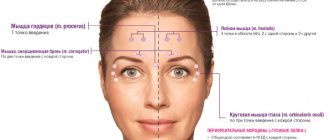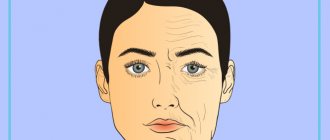Are you ready to inject yourself in the face with a terrible poison, four kilograms of which can destroy all of humanity? Get to know: botulinum toxin is the active ingredient of Botox, used to smooth out wrinkles and treat muscle dysfunction. The “miracle” of the late 20th century, which enriched its creators with billions of dollars and crippled the natural beauty of millions of women.
The cosmetic industry everywhere imposes injections of botulinum poison. They claim that it is highly diluted and therefore safe. This is wrong. The very principle of its effect is pathological: botulinum toxin paralyzes nerve impulses and atrophies muscles. The effects of Botox on the face are ugly and unhealthy. A woman before and after injections are two different organisms. And “before” is always much better.
Therefore, before you step over this line of no return, look at the photos of the “victims” before and after using Botox for the face. Understand the mechanism of action of this drug, all its proclaimed “pros” and real cons.
What is Botox
Botox is a drug based on Botulinum toxin, the most powerful organic poison in the world.
Botulinum toxin is a neurotoxin, that is, a poison that affects nerve cells. It has many names: botulinum toxin, botulinum toxin, botulinum poison. Literally, Botulinum toxin translates as “sausage poison.” It received this name because it was discovered as the causative agent of mass food poisoning with ham with fatal outcomes (19th century). It turned out that spoiled sausage produces the terrible bacterium botulism (Clostridium Botulinum), which causes the disease of the same name, which manifests itself in severe damage to the nervous system as a result of toxin poisoning.
Initially, the military decided to use the damaging effect of botulinum toxin. Experiments with this poison as a bacteriological weapon were conducted in several countries. And its production was first established in the USA: during the Second World War, highly purified botulinum toxin type A (BTA) - the most dangerous for humans - was obtained here. About 30 years later, the BTA was adopted by the US Army under the code XR. It had the form of an aerosol and killed the enemy within three days after exposure to the gas.
It was BTA, created as a biological weapon, that became widespread in medicine and cosmetology.
Botulinum toxin was first adopted by ophthalmologists, using it to treat a variety of muscle disorders of the eyes: strabismus, involuntary spasms in the form of blinking (blepharospasm) and frequent oscillatory eye movements (nystagmus). Then the scope of application expanded. Botulinum toxin has been used to correct a variety of neuromuscular disorders of the face, neck, and legs, ranging from teeth grinding (bruxism) to cerebral palsy. BTA also began to be used for headaches and excessive sweating.
The main jackpot from putting biological weapons on the rails of commercial medicine was hit by the Irish company with American roots, Allergan. It was she who launched the production of BTA for medicine (later for cosmetology), called it “Botox” and now earns about 3 billion dollars a year from this.
Botox came to cosmetology in the early 90s after a side effect was discovered from its treatment of muscle disorders of the eye: the patient's skin between her eyebrows became smoother.
Xeomin
This is the youngest drug to appear on the Russian market. Its feature is a high degree of purification of botulinum toxin, therefore it is considered the safest of all. Xeomin contains albumin, which makes it resistant to environmental influences, and most importantly, active facial expressions are maintained.
Xeomin consists of small molecules and works in the immediate vicinity of cellular tissue, so its duration of action is short - up to six months. The first results after Xeomin injections are visible already on days 2-3, and the final result will be obvious on days 12-14. If patients who do Botox become addicted to it, then Xeomin will be a good alternative for replacement.
Main types of Botox
Usually the word “Botox” is used as a common noun to refer to the entire category of drugs used for botulinum therapy. Although, in the strict sense of the word, Botox is a trademark, that is, just one of a number of drugs based on botulinum toxin. Botox is the first and main drug based on BTA, but not the only one.
There are also trademarks of other manufacturers: Dysport, Botulax, Neuronox, Refinex, Xeomin, Nabota, Meditoxin. They are made in the UK, South Korea, France, and Germany. They also established their production of “miraculous” injections of “youth” in Russia, calling the poisonous product the serene name “Relatox”.
All these drugs contain the same active ingredient – botulinum toxin type A in a highly diluted form. The same BTA, once developed as a biological weapon for military and sabotage purposes.
Drug comparison table - which one is better to inject in the face
You will understand which Botox and which brand is better to inject in the face from the drug comparison table:
| Name | Manufacturer country | price, rub. for 1 ampoule | Efficiency | Side effects |
| Botox | USA | 450 | Six months | Allergy |
| Dysport | France | 200 | 4 months | Allergy |
| Xeomin | Germany | 330 | 4 months | Virtually none |
| Lantox | China | 350 | Up to 9 months | Allergies, swelling, rash, bruises, upset stomach. |
| Neuronox | South Korea | 250 | Up to 7 months | Allergy |
| Relatox | Russia | 320 | Up to 9 months | Allergy |
| Botulax | South Korea | 160 | Six months | Allergy |
| Refinex | Japan | 4300 | Up to 3 months | Allergy |
How does Botox work?
The so-called benefit of Botox for the face consists of a temporary cosmetic effect: wrinkles in the injection area are smoothed out for 2-5 months. But this is a misleading result. Even highly diluted poison remains poison and causes irreparable harm to beauty and health. It is the damaging properties of botulinum toxin that formed the basis for its cosmetic use.
The mechanism of Botox’s effect on expression lines is insidious. Botulinum toxin blocks acetylcholines, whose function is to transmit nervous excitement. The signal from the nerve to the muscle stops. No nerve impulses - no movement in the muscle. She becomes paralyzed and stops working. This is “relaxation” - an immobilized, non-living face.
Botulinum toxin in cosmetology
Rejuvenation using botulinum toxin injections is one of the most popular aesthetic medicine techniques. Botulinum toxin has been used in cosmetology for almost thirty years. During this period, a huge number of clinical trials have been conducted that have proven the safety and high effectiveness of Botox therapy.
Botulinum toxin: application in cosmetology
In cosmetology, botulinum toxin is used in anti-aging procedures. The purpose of the injections is to eliminate age-related defects in the form of hyperkinetic wrinkles on the face and neck, the formation of which is caused by an increase in the tone of the facial muscles. After injections of botulinum toxin, the transmission of nerve impulses to muscle fibers is blocked, muscle contraction becomes impossible, it relaxes, as a result of which wrinkles are smoothed out.
Areas of use
- Temporofrontal region (forehead and temples).
- Lateral corners of the eyes (“crow’s feet”).
- Between the eyebrows (wrinkles of “anger”).
- Bridge of the nose.
- The area above the upper lip and around the mouth.
- Chin.
- Lower jaw line.
- Neck.
With Botox injections, you can smooth out horizontal wrinkles on the forehead, remove fine wrinkles in the corners of the eyes or purse-string wrinkles around the mouth. During the procedure, you can successfully solve other aesthetic problems, for example, lifting the drooping corners of the mouth or the outer corners of the eyes. Anti-aging procedures give a quick effect, it lasts for 4-8 months. How long the result will last depends on the botulinum toxin drug chosen for correction and the individual characteristics of the patient.
The second area of application of botulinum toxin in cosmetology is the treatment of hyperhidrosis. The problem of increased sweating worries many; deodorants do not always give the desired effect, but often provoke irritation and inflammation of the skin. Surgical treatment of hyperhidrosis is associated with certain risks. Botulinum toxin injections allow you to forget about the problem for a long time without complications or unpleasant consequences. Botulinum toxin is used mainly for the correction of palmar, plantar and axillary hyperhidrosis.
Botulism neurotoxin: mechanism of action
A few words about how exactly the mechanism of action of drugs based on botulinum toxin is implemented. The active component is botulinum neurotoxin type A. This is a high molecular weight protein compound that can block the release of acetylcholine from nerve fibers.
Acetylcholine is a key neurotransmitter of the nervous system, through which signals from nerve endings are transmitted to muscles and other tissues (including sweat glands). Botulinum toxin penetrates the nerve ending and binds to the specific protein SNAP-25. This protein performs a transport function: it is necessary for the transfer of vesicles containing acetylcholine to the cell membrane.
The attachment of botulinum toxin to this protein blocks the operation of the entire transport system. As a result, vesicles with mediator cannot attach to the cell membrane. Acetylcholine cannot leave the nerve endings, as a result of which they cannot transmit a signal to the muscles or sweat glands. The transmission of the signal from the nerves to the peripheral organs is interrupted, which leads to the desired effect.
When correcting wrinkles, blocking the transmission of nerve impulses with botulinum toxin is accompanied by relaxation of the fibers of facial muscles, which is externally manifested by the smoothing of wrinkles. When treating hyperhidrosis, the blockage of nerve fibers is manifested by slowing down and stopping the functioning of the sweat glands, so that sweating stops for a period of six to ten months.
Preparations with botulinum toxin
The mechanism of action described above is characteristic of all types of botulinum toxin without exception, since the active component of each product is botulinum neurotoxin type A. However, there are still some differences between the various drugs presented on the pharmaceutical market. They concern mainly the duration of the effect and the specifics of its manifestation.
The American drug Botox was the first to appear on the market, which to this day remains the most famous and popular botulinum toxin drug. Initially, it was used in ophthalmic practice in the treatment of certain eye diseases. Ophthalmologists noted that one of the “side effects” of Botox is the smoothing of wrinkles around the eyes, especially pronounced in older patients.
After this discovery, the prospects for using Botox in cosmetology began to be studied. It turned out that Botox effectively copes not only with wrinkles in the periorbital zone, but also with age-related defects in other areas of the face. At the same time, other companies were developing a promising product for aesthetic medicine, in particular, the French pharmaceutical giant Beaufour Ipsen, the creator of the alternative drug Dysport. A little later, the Chinese Lantox and the German drug Xeomin appeared on the market.
Today, Moscow clinics use various drugs with botulinum toxin. The highest quality of them are:
- Original Botox.
- French Dysport.
- German Xeomin.
- Chinese Lantox.
Let us say once again that all botulinum toxin preparations have the same mechanism of action, based on blocking the release of acetylcholine from the nerve endings of the correction zone. However, in one case, a cosmetologist may recommend Dysport, and for another procedure, Botox injections. Because of this, the patient often has a question, which of these drugs is better?
Botox or Dysport: which is better?
We need to start with the fact that Botox and Dysport are excellent means for treating hyperhidrosis and correcting facial wrinkles. It cannot be said that one of the drugs is better or worse. It would be more correct to say that there are some differences between them.
American Botox toxin has a higher molecular weight. Because of this, it takes longer to penetrate inside the nerve fibers, and the effect does not occur immediately. Typically, it takes 7-14 days to block the nerve endings; only after this time can the final effect of the procedure be assessed. For the same reason (high molecular weight), the toxin is removed from tissues more slowly, so the effect lasts longer.
Another important feature of large macromolecular complexes is the lower degree of diffusion. Diffusion of a toxin is the process of distributing it in the tissues adjacent to the injection points. After Botox injections, the toxin migrates weakly, which allows Botox to be used for spot correction, for example, to smooth out wrinkles in the corners of the eyes.
Dysport contains a toxin with a lower molecular weight, as a result of which it differs from Botox in the characteristics listed above. Botulinum toxin penetrates the nerve endings faster, the effect occurs earlier (on 3-4 days), but it also lasts less. Dysport is characterized by diffusion over long distances, which is undesirable for spot correction, but very useful for rejuvenating large areas, for example, the frontal area.
Features of the procedure
Injection of botulinum neurotoxin can only be performed by a cosmetologist who has the appropriate certificate confirming the right to carry out such procedures. The result of the correction largely depends on the doctor’s qualifications.
It is important to correctly mark the injection points for Botox, correctly determine the total dose and correctly distribute it between the intended injection points. The final result is also influenced by the depth of needle insertion and its direction (the drug should be injected strictly perpendicular to the direction of the muscle fibers).
The procedure itself takes place with minimal discomfort and takes no more than 20-30 minutes (depending on the correction area). Despite the simplicity of the correction for the patient, it is necessary to properly prepare for a botulinum therapy session. You cannot exercise on the day of the procedure. A week before the session, you cannot visit the sauna or solarium, and you cannot undergo other cosmetic procedures.
Women should not schedule Botox injections during the first days of their menstrual cycle. In addition, if you are undergoing antibiotic treatment, injections can be given no earlier than 2-3 weeks after its completion. Finally, a week before the procedure, it is advisable to stop taking medications that slow down blood clotting.
Recommendations after injections
The final result is also influenced by how responsibly the patient treats the recommendations of the recovery period. These recommendations are simple, they are as follows:
- After Botox injections, you should not expose your body to high temperatures. Solarium, hot baths, sauna, steam room, spa treatments are contraindicated for 2 weeks.
- For the same reason, you should not play sports (physical activity is accompanied by an increase in body temperature).
- Alcoholic drinks are prohibited for 2 weeks. It is advisable not to smoke.
- Cosmetology procedures are contraindicated for 2 weeks, including hardware and injection cosmetology procedures.
- You should not take antibiotics, antiplatelet agents, or anticoagulants.
- Please note that after Botox injections it is not recommended to take dietary supplements that contain B vitamins.
Compliance with the recommendations will help to avoid aesthetic complications caused by the migration of the toxin outside the correction zone. The cause of excessive diffusion of the active substance is often an increase in body temperature, which, like alcohol, increases peripheral circulation and promotes the spread of the neurotoxin.
Ignoring the rules of the recovery stage can lead to the development of complications such as drooping of the upper eyelid or eyebrows, double vision, facial asymmetry, and keratoconjunctivitis sicca. The cause of complications may also be the low qualifications of the cosmetologist, so trust the procedure only to experienced specialists with an impeccable reputation.
Contraindications to the use of botulinum toxin
Botox injections are not performed at the beginning of the menstrual cycle, or if there are signs of inflammation on the skin (erythema, rash, peeling). An absolute contraindication to the administration of botulinum toxin is:
- Pregnancy, lactation.
- Oncological tumor, regardless of its location.
- Myasthenia.
- Diseases of the endocrine system in the stage of decompensation.
- Chronic diseases of internal organs in the acute stage.
- Pathology of the heart and blood vessels in the stage of decompensation.
You can obtain detailed information about the use of botulinum toxin in cosmetology at an individual consultation with a medical cosmetologist (Moscow).
Why is Botox dangerous?
Someone, influenced by the inspired rhetoric of cosmetologists, may object: “Just think! The muscle is not removed. He’ll rest a little and recover in six months.” No no and one more time no!
- Firstly, it will not recover. There is clinical evidence that even after a single injection of Botox, the muscle does not return to its previous state.
- Secondly, we understand that everything in the body is interconnected. If one muscle does not function, then others work hard for it, without stopping to perform their usual load. And these are serious, deep-seated problems! Muscles, forced to work for their atrophied colleagues in the workshop, become overstrained, wear out faster, and the vectors of skin tension change. And the owners of a smooth and motionless forehead after a few months clutch their heads: not only the old problems have returned, but also a lot of new wrinkles, bumps, and creases have appeared. What to do? Urgently run to the cosmetologist for a new dose of poison.
- Thirdly, scientists have proven that botulinum toxin spreads throughout the body. Only part of it is retained in the injection area. The rest of the neurotoxin moves menacingly and unpredictably from neuron to neuron. It is impossible to predict when and what part of the body affected by the poison may be paralyzed.
- Fourthly, side effects from Botox use kill beauty and health. And they are not a rarity, but a pattern.
Consequences after Botox for the face
The most harmless side effect of Botox injections into the face is bruising. The needle damages the vessel and a hematoma develops, which usually does not go away for about a week. 9 out of 10 patients experience this.
But Botox injections are fraught with much more unsightly changes in the face:
- Sliding and overhanging of the forehead muscles, atrophied due to poison, over the eyes. Paralyzed muscles pull down the eyelids and eyebrows. This is the most popular negative effect of Botox for the face.
- Closed or half-closed eyes. This disorder is the result of paralysis by Botox of non-target muscles located in the vicinity of the injection site.
- Scary bumps above the eyebrows. Appear due to uneven distribution of muscle tone at the injection site. They still hurt.
- Eyelid hernias and swelling.
- Uncontrollable grimaces - instead of healthy facial expressions that correlate with emotions.
- "Mask-like" face.
- Crooked smile.
- Facial asymmetry.
In addition to aesthetic side effects, there is a whole tome of harmful health effects of Botox. Here are just a few of them:
- headaches and migraines,
- osteoporosis of the skull,
- disturbances in the functioning of the cranial nerves,
- disturbance in the functioning of the nerve centers of the heart,
- skeletal muscle dysfunction,
- speech disorder,
- swallowing disorder
- anisocoria of the pupils (different sizes),
- mydriasis (pupil dilation),
- strabismus,
- blindness.
If you were wondering about the pros and cons of Botox for the face, we hope we answered it. There are no advantages. Only disadvantages. Botox pushes the aging process of the face, gives ugly complications and puts the health of the entire body at risk.
Indications for the use of Botox
Cosmetologists urge Botox injections into the face of those who have facial wrinkles, “jowls” (sagging skin in the cheeks and chin), unclear contours, and facial asymmetry.
A terrible trend is to drag young girls into their networks. Botox for the face, it turns out, is already “necessary” for 25-year-olds, in order to prevent age-related changes. Nonsense!
Don't fall into this trap! Once again in capital letters: BOTOX ACCELERATES AGE CHANGES IN THE FACIAL. And at the same time, having injected yourself once or twice, you will become hooked on the needle. And there will be no way out of this vicious circle.
There are quite a few official contraindications to the use of Botox: oncology, chronic diseases of internal organs, infections, hernias and ptosis of the eyelids, pregnancy, poor skin coagulability. But common sense dictates that Botox for the face for aesthetic purposes is contraindicated for everyone!
Progress of the procedure
It is necessary to prepare for botulinum therapy 3 days before the session:
- give up physical activity, sports, and drinking alcoholic beverages;
- stop taking medications that affect blood clotting and B vitamins;
- Do not use antiperspirants before treating hyperhidrosis.
Before the session, the cosmetologist must conduct a consultation, talk about preparation, preferred medications, and behavior after the session.
The procedure takes about half an hour. Makeup is removed and the skin is treated with an antiseptic. An anesthetic cream may be used. Markings are applied to the skin, and botulinum toxin is injected into the planned muscle areas using a syringe and needle.
After botulinum toxin injections, follow the cosmetologist's recommendations to avoid complications.
Possible recommendations:
- apply a cold compress to the treated area of the face;
- do not smile or frown for half an hour;
- Do not take a vertical position for 3-4 hours;
- Avoid physical activity and bending for 3 days;
- do not touch your face with your hands;
- for 2 days do not apply cosmetics to your face and do not dry your hair with a hot hairdryer;
- 2 weeks after the session do not visit baths, saunas, swimming pools and do not sunbathe.
How much does it cost to get Botox poisoning?
Those who get hooked on the needle leave serious money with the cosmetologist, and this is what is called a “loyal” clientele that is not going anywhere. The affected women see no other way out. You have to inject Botox into your face first 2 times a year, then 4-5 times. After all, the skin slips and wrinkles.
The price of Botox for the face depends on the area being treated and the volume of the drug injected. One unit of this substance in Russia, according to average prices, costs 300-400 rubles. But you need a lot of units, a lot!
For example, it is stated that to smooth out wrinkles on the forehead, 10-30 units will be needed, for the eyebrows – 10-15, for “crow’s feet” in the eye area – 5-15 doses on each side, for “rabbit wrinkles” (transverse folds on back of the nose) – 5-10. It is also proposed to treat the chin area with poison, raise the eyebrows, and the corners of the lips. It takes 40-60 units to smooth the jaw line. Wrinkles on the neck require 25-50 units. But these are only preliminary figures. In fact, it turns out that more Botox is needed, it often does not “get up” after the first procedure, a second or third is required.
We count. If a client is already hooked on Botox and is injected with it from the neck to the top, one visit to a cosmetologist may require more than 50 thousand rubles. This is if he goes to a budget clinic, and not to a well-known cosmetologist. Otherwise, the overpayment for “competence” (“AA herself goes to her,” she has “competent techniques,” “safe doses”) cannot be calculated.
Dysport
Dysport not only eliminates wrinkles, but also helps treat neurological diseases.
The doctor prescribes the dosage depending on the depth of wrinkles and their number, location on the face, skin properties, and the patient’s age. Due to its fastest spreading rate, Dysport is best suited for use on the forehead and also for:
- smoothing wrinkles between the eyebrows, nose, neck;
- eliminating crow's feet;
- reducing excessive sweating;
- relaxation of muscle tissue tense after a stroke.
The procedure takes from 10 to 30 minutes. Due to the use of very thin cannulas, the skin is almost not injured, so no rehabilitation is required. The drug has a cumulative effect, so the result occurs only after two weeks. The duration of the effect lasts from 4 to 6 months.











